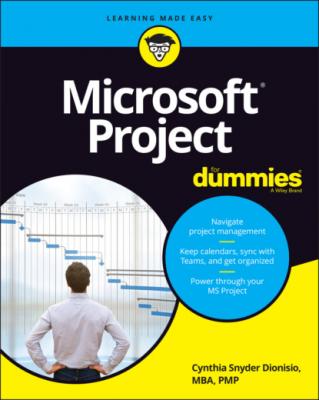Microsoft Project For Dummies. Cynthia Snyder Dionisio
Чтение книги онлайн.
Читать онлайн книгу Microsoft Project For Dummies - Cynthia Snyder Dionisio страница 14
 ask it to, such as insert a milestone or highlight critical tasks.
ask it to, such as insert a milestone or highlight critical tasks.
Chapter 2
Starting the Project
IN THIS CHAPTER
Congratulations — you’re the proud project manager of a new project! Before you do anything, you need to understand the scope of the project. You must clearly specify what’s in and out of scope, milestones, the budget, and completion criteria.
Planning a project isn’t as easy as opening a file in Project and entering all the activities you have to complete. Before you can begin to plan, you need to understand the purpose of the project and the high-level information about the project such as project’s objectives and the intended outcomes.
Therefore, before you enter the first task into Project, you create the project charter (described a little later in this chapter) to initiate the project and develop the work breakdown structure (WBS) to organize project deliverables. Then you can start organizing the project and entering tasks into Project.
This chapter describes how to move from imagining a concept to planning a project so you know how to enter and work with tasks and how to save the new project.
Creating the Project Charter
Having a high-level understanding of a project is critical to project success. The project charter is a document that formally authorizes or recognizes a project; it contains high-level information about the project. The project charter is frequently developed by the project manager, with the project sponsor. The charter functions as an agreement about the purpose and objectives of the project.
Common elements of a project charter are:
Purpose
Description
Objectives
Criteria for completion
Summary milestone schedule
Summary budget
The high-level information in the charter provides background information to help you plan the project approach and organize the work logically. Using the information from the charter, you can start to define the project’s major deliverables and its life cycle — and your approach to accomplishing all the project work.
© John Wiley & Sons, Inc.
FIGURE 2-1: The Desert Rose Security project charter.
Introducing the Work Breakdown Structure (WBS)
If you have a small project, you may be able to start entering tasks into Project and organize them on the fly. But for any project with more than 50 tasks, consider how to structure and organize the work before you open Project. One best practice is to create the work breakdown structure, or WBS — a hierarchically organized representation of all the project work.
Generally, you approach the WBS from the top down. In other words, you evaluate the entire project and then break it into large chunks, and then break the larger chunks into smaller chunks, and so on, until you have a defined deliverable. That’s where the WBS stops and project tasks begin.
The WBS houses all deliverables for the project and product scope. It doesn’t include the tasks. Those are strictly for the schedule. Another way of thinking about the WBS is that it’s composed of nouns, whereas the schedule is composed of actionable verbs. For example, the Perimeter Fencing might be the lowest-level deliverable you would show on the WBS. Then define these tasks for the schedule using the “verb-noun” naming convention:
1 Identify fencing requirements.
2 Develop request for quote.
3 Receive quotes.
4 Select vendor.
5 Develop contract.
6 Sign contract.
7 Oversee fence installation.
Organizing the Work
Frequently,